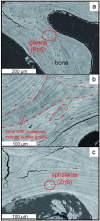A Case of Syphilis with High Bone Arsenic Concentration from Early Modern Cemetery (Wroclaw, Poland)
- PMID: 33817178
- PMCID: PMC7874782
- DOI: 10.1515/biol-2019-0048
A Case of Syphilis with High Bone Arsenic Concentration from Early Modern Cemetery (Wroclaw, Poland)
Abstract
Venereal syphilis is a sexually transmitted disease caused by Treponema pallidum - Gram-negative, slowly growing bacteria. The spread of the disease in the Old World was due to increased birth rate, urban population growth, migration and lack of knowledge concerning the epidemiology. In the past, the treatment was mainly symptomatic and included application of mercury compounds. The goal of the study was to present the case of advanced venereal syphilis found in early modern (16th-18thc) graveyard localized in Wroclaw, Poland. The object of the study is a cranium of a male whose age at death has been estimated to be over 55. In order to observe the morphological and paleopathological characteristics of the examined material, anthropometrics, computed tomography, spectrometry and microscopic methods were incorporated. Microscopic analysis revealed the presence of the extensive inflammatory lesions. Analyses indicate tertiary stage of venereal syphilis as the most probable cause of the observed lesions. Concentration of arsenic (16.17±0.58 μg/g) in examined bone samples was about hundred times bigger than average arsenic concentration in bones reported in other studies. Advanced stage of observed lesions along with high arsenic level may suggest long-lasting palliative care and usage of arsenic compound in therapeutic treatment of this chronic disease.
Keywords: bioarchaeology; mercury; paleopathology; syphilis; treponematoses.
© 2019 Pawel Dabrowski et al., published by De Gruyter.
Conflict of interest statement
Conflict of interest Conflict of interests: Authors state no conflict of interest .
Figures






Similar articles
-
Diagnostic Methods Used in Detecting Syphilis in Paleopathological Research-A Literature Review.Diagnostics (Basel). 2025 Apr 28;15(9):1116. doi: 10.3390/diagnostics15091116. Diagnostics (Basel). 2025. PMID: 40361935 Free PMC article. Review.
-
First Paleogenetic Evidence of Probable Syphilis and Treponematoses Cases in the Brazilian Colonial Period.Biomed Res Int. 2018 Oct 10;2018:8304129. doi: 10.1155/2018/8304129. eCollection 2018. Biomed Res Int. 2018. PMID: 30406142 Free PMC article.
-
Syphilis at the crossroad of phylogenetics and paleopathology.PLoS Negl Trop Dis. 2010 Jan 5;4(1):e575. doi: 10.1371/journal.pntd.0000575. PLoS Negl Trop Dis. 2010. PMID: 20052268 Free PMC article.
-
Syphilis 2001--a palaeopathological reappraisal.Homo. 2002;53(1):39-58. doi: 10.1078/0018-442x-00037. Homo. 2002. PMID: 12365355
-
The "Scourge of the Renaissance". A Short Review About Treponema pallidum infection.Endocr Metab Immune Disord Drug Targets. 2020;20(3):335-343. doi: 10.2174/1871530319666191009144217. Endocr Metab Immune Disord Drug Targets. 2020. PMID: 31625831 Review.
Cited by
-
Historical overview and new directions in bioarchaeological trace element analysis: a review.Archaeol Anthropol Sci. 2021;13(1):24. doi: 10.1007/s12520-020-01262-4. Epub 2021 Jan 15. Archaeol Anthropol Sci. 2021. PMID: 33520004 Free PMC article. Review.
-
Diagnostic Methods Used in Detecting Syphilis in Paleopathological Research-A Literature Review.Diagnostics (Basel). 2025 Apr 28;15(9):1116. doi: 10.3390/diagnostics15091116. Diagnostics (Basel). 2025. PMID: 40361935 Free PMC article. Review.
-
Syphilis: then and now.Postepy Dermatol Alergol. 2021 Aug;38(4):550-554. doi: 10.5114/ada.2021.108930. Epub 2021 Sep 17. Postepy Dermatol Alergol. 2021. PMID: 34658692 Free PMC article. Review.
References
-
- Tagarelli A, Tagarelli G, Lagonia P, Piro A. A brief history of syphilis by its synonyms. Acta Dermatovenerologica Croat. 2011;19(4):228–236. - PubMed
-
- Suzuki T. Palaeopathological and palaeoepidemiological study of osseous syphilis in skulls of the Edo period. University of Tokyo Press; 1984. https://catalog.hathitrust.org/Record/000566303 Accessed 16 March 2017.
-
- Grmek MD. Historia chorób u zarania cywilizacji zachodniej. Warszawa: W.A.B; 2002.
-
- Marden K, Ortner DJ. A case of treponematosis from pre-Columbian Chaco Canyon, New Mexico. Int J Osteoarchaeol. 2011;21(1):19–31.
-
- Gawlikowska-Sroka A, Dzięciołowska-Baran E. Syphilis in the past and present. Ann Acad Med Stetin. 2013;59(2):162–165. - PubMed
LinkOut - more resources
Full Text Sources
Miscellaneous
